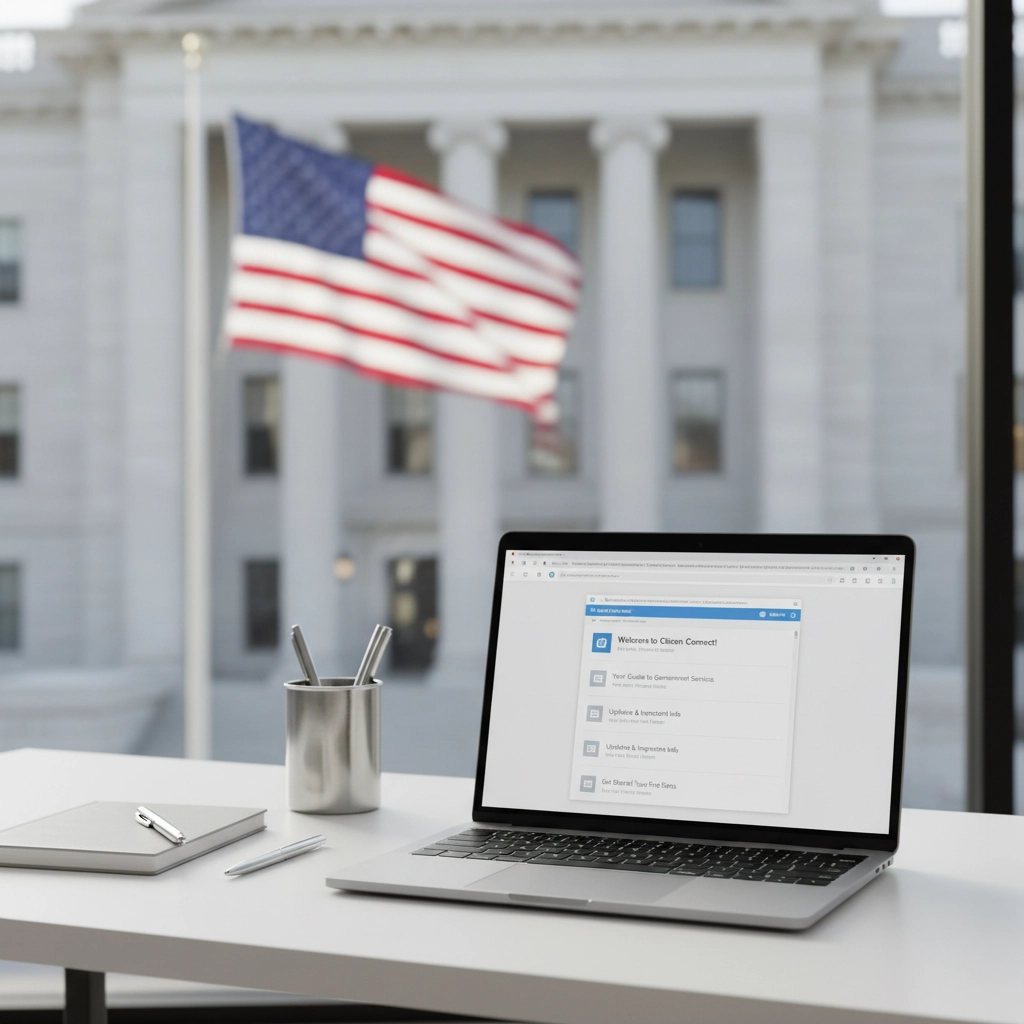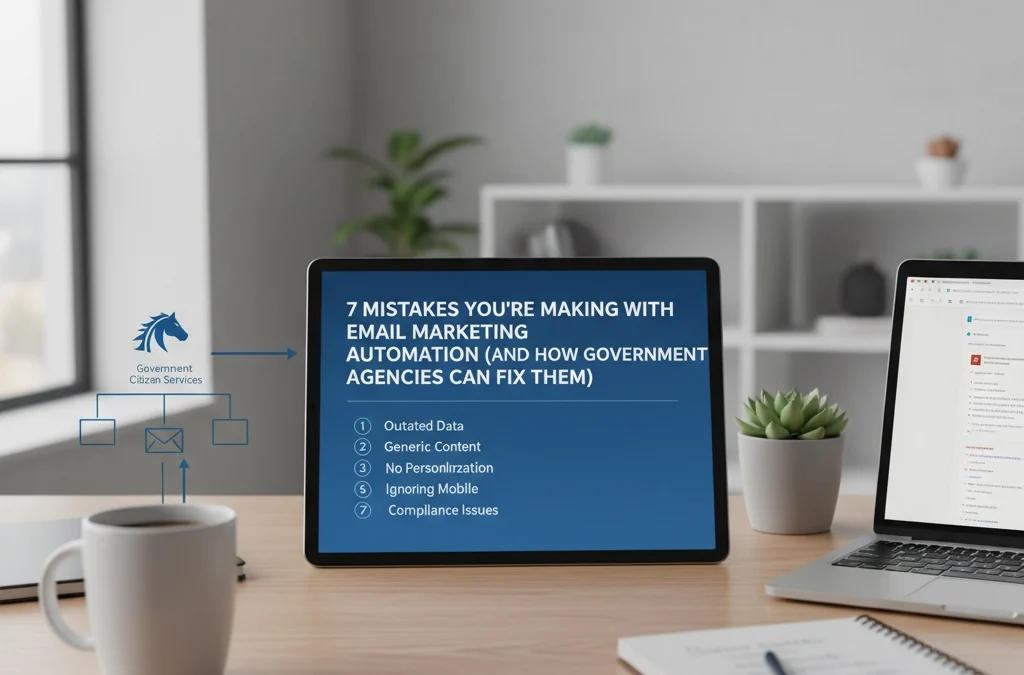Email marketing automation mistakes cost government agencies millions in lost engagement and missed opportunities. The seven most common errors include overcomplicated workflows, poor subscriber management, batch-and-blast tactics, inadequate segmentation, poor timing, ineffective autoresponders, and compliance oversights. Smart agencies fix these by simplifying processes, implementing welcome campaigns, personalizing content, optimizing timing, and maintaining strict data governance protocols.
Email marketing automation should be your secret weapon for connecting with citizens, stakeholders, and constituents. Instead, most government agencies are shooting themselves in the foot with preventable mistakes that kill engagement and waste taxpayer resources.
You've probably invested in sophisticated email platforms, hired marketing teams, and developed communication strategies. But if your open rates are struggling and your citizen engagement feels flat, you might be making one (or several) of these critical errors.
Let's dive into the seven biggest email marketing automation mistakes that government agencies make, and more importantly, how to fix them fast.
Mistake #1: Building Overcomplicated Workflows
Your email automation shouldn't require a PhD in computer science to understand. When workflows try to accomplish too much at once, they often fail to deliver results as intended. Complex setups confuse both the system and your audience, causing messages to be delayed, sent out of order, or worse, not sent at all.
Government agencies are particularly guilty of this. You want to cover every scenario, address every constituency, and account for every possible citizen journey. The result? A Frankenstein workflow that's impossible to manage and even harder to optimize.
The Fix: Simplify your workflows ruthlessly. Each automation sequence should have one clear purpose and guide recipients smoothly from one step to the next. Start with basic welcome sequences, then expand gradually. This makes it easier to identify what's working and troubleshoot problems quickly.
Mistake #2: Leaving New Subscribers Hanging
New subscribers represent some of your most valuable contacts. They've actively demonstrated trust and engagement with your agency by signing up for updates. Yet many government organizations delay their first communication for days, weeks, or even months, missing a critical window for conversion and engagement.
Think about it from a citizen's perspective. They sign up for city council updates or emergency alerts, then hear nothing for two weeks. What message does that send about your agency's responsiveness?
The Fix: Implement an automated welcome campaign that triggers immediately after subscription or within 24 hours at the latest. Prepare this campaign in advance so it activates automatically when someone subscribes, acknowledging their interest and establishing your communication cadence.

Mistake #3: Using Batch-and-Blast Email Tactics
Sending one generalized email to your entire database without segmentation or personalization is like using a sledgehammer when you need a scalpel. This outdated approach wastes your automation platform's capabilities and treats all subscribers identically, regardless of their interests, location, or relationship with your agency.
Government agencies often fall into this trap because it seems efficient. One message about road construction goes to everyone, whether they live in the affected area or not. One tax deadline reminder hits every subscriber, regardless of whether they're a business owner or individual taxpayer.
The Fix: Segment your mailing lists into specific groups and tailor every campaign to each recipient using personalization and dynamic content tools. If you're promoting a community meeting, send invitations only to constituents in the relevant district. If you're sharing business resources, target registered business owners specifically.
Mistake #4: Ignoring Segmentation and Personalization
One-size-fits-all nurture campaigns that ignore individual user behavior and preferences fail to resonate with recipients. When citizens receive irrelevant information repeatedly, they tune out your messages entirely.
Your automation platform collects valuable data about subscriber behavior, interests, and engagement patterns. Not using this information is like having a detailed map but choosing to drive blindfolded.
The Fix: Use your platform's data and behavior tracking to create targeted segments. Personalize not just the greeting, but the content itself. Address specific needs, pain points, or interests relevant to each segment. Veterans should receive different content than small business owners, even if they both subscribe to your economic development newsletter.

Mistake #5: Poorly Timed Automated Messages
Automation triggers that fire too soon, too late, or at ineffective times reduce engagement and can frustrate recipients. A welcome message sent hours after signup feels disconnected, while a public meeting reminder sent during overnight hours may go unnoticed.
Government agencies must be particularly mindful of timing. Citizens expect timely, relevant information, especially for time-sensitive matters like emergency alerts, deadline reminders, or meeting notifications.
The Fix: Test different send times and trigger delays to determine what works best for your audience. Consider your constituents' typical work schedules and when they're most likely to engage with official communications. For emergency alerts, immediate triggers are essential. For newsletters, test morning vs. evening sends to optimize engagement.
Mistake #6: Underutilizing Autoresponders
Many agencies set up welcome emails but don't leverage the full potential of email drip campaigns and autoresponders. These are automated sequences triggered by specific actions like downloading forms, registering for events, or requesting services.
This represents a massive missed opportunity. When a citizen downloads your small business guide, that's the perfect time to automatically follow up with related resources, upcoming workshops, or contact information for business advisors.
The Fix: Create multi-step autoresponder sequences that nurture leads after key interactions. After someone downloads a guide from your website, automatically send a welcome message, followed by related advice or opportunities a few days later. This keeps your agency top-of-mind and provides ongoing value.
Mistake #7: Neglecting Compliance and Suppression Rules
Many agencies focus heavily on who to send emails to but overlook equally important suppression rules defining who should not receive campaigns. Additionally, government organizations must contend with strict data protection and compliance requirements that are often overlooked in automation workflows.
This isn't just about avoiding spam complaints. Government agencies have heightened responsibilities for protecting citizen data, maintaining accessibility standards, and ensuring consistent brand messaging across all communications.
The Fix: Implement robust suppression lists based on behavior, preferences, and compliance requirements. Establish an information governance framework that ensures every campaign flows through compliance checkpoints. Suppress event registrants from reminder campaigns, exclude people who've opted out of specific topics, and maintain detailed records for audit purposes.
For government agencies especially, automated quality controls and validation checkpoints become increasingly important as communication volume scales. You can't rely on manual reviews when you're sending thousands of automated messages monthly.
The Bottom Line
Email marketing automation isn't rocket science, but it does require attention to detail and strategic thinking. Government agencies that master these fundamentals will see dramatically improved citizen engagement, better resource utilization, and more effective public communication.
The key is starting simple and building complexity gradually. Fix these seven mistakes one at a time, measure your results, and iterate based on what works for your specific audience and objectives.
Remember, every automated email you send represents your agency's professionalism and commitment to serving constituents effectively. Make sure you're putting your best foot forward.
Ready to transform your government agency's email marketing? Contact Ride Fear Free, LLC for expert advertising and marketing automation solutions.
Website: www.RideFearFree.net
AI Receptionist: +1 (970) 693-4854
CEO: Dan Kost
Connect with Dan: LinkedIn Profile
Share this post:
Tags: #Motivation #Branding #Strategy #Marketing #AdvertisingAndMarketing #digitalmarketing #Innovation #Sports #EmailMarketing #GovernmentAgencies #MarketingAutomation #PublicSector #CitizenEngagement #DigitalGovernment

